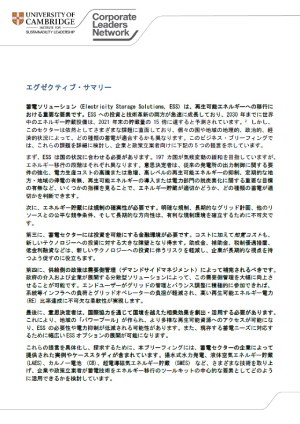18 May 2023 - On the eve of the G7 summit in Japan, the Corporate Leaders Network for climate action highlights the vital role of storage in unlocking clean energy’s full potential in its first publication, suggesting cross-border cooperation as a vital catalyst to pool power and share storage options, and highlights the need for regulatory certainty.
Read the business briefing.
Investment and innovation are both growing rapidly: by 2030, energy storage installations around the world are projected to reach fifteen times the amount of storage that was online at the end of 2021. However, the energy sector still faces a range of challenges, and the suitability of different types of storage depends on the geographical, political and economic circumstances of individual countries and regions.
To illustrate and explore these policy recommendations, the briefing contains real-world examples and case studies provided by businesses in the energy storage sector. It considers a range of technologies, including storage hydropower, liquid air energy storage (LAES), and Carnot batteries (CBs). Fundamentally, the briefing examines how businesses and policymakers can utilise electricity storage (ES) technologies as a central component of a larger energy transition toolkit. In acting on these recommendations, both businesses and policymakers have instrumental roles: the former by investing and innovating and the latter by serving as a convening force and ensuring an enabling environment for investment and progress. Policymakers and businesses must continue to work in tandem to harness the potential of the ES sector, and the central role it can play in achieving net zero targets.
Key recommendations of the business briefing:
- Electricity storage solutions (ESSs) should be tailored to the country context. While 197 nations are united in the mission to mitigate climate change, they are each at different stages of the energy transition. Decision-makers can look at several indicators to identify whether and which type of energy storage is appropriate, including increasing ramping requirements for conventional power plants, high or spiking electricity production costs, high levels of renewable energy curtailment, regular local and/or regional power disruptions, and the presence of significant targets for renewable energy deployment or power sector decarbonisation.
- Electricity storage requires regulatory certainty. Clear regulations, long-term grid planning, a level playing field with other resources, and a long-term direction of travel are all essential for establishing a conducive regulatory landscape.
- The storage sector requires an enabling financial environment for investment. Cost, as well as perceived cost, can present significant barriers to investment in new technologies. Grants, subsidies, tax incentives and low-interest loans may help to reduce the risks associated with investing in new technology and encourage businesses to take a long-term view.
- Supply-side policies should be supplemented with demand-side management. Government intervention, as well as distributed solutions deployed by businesses, can significantly enhance demand-side management. If end-users can actively participate in managing and balancing the grid then this will ease the burden on infrastructure and on grid operators, enabling the flexibility which is essential for achieving high levels of renewable electricity (RE) generation.
- Decision-makers must leverage cross-border synergies through international cooperation. This can create regional ‘power pools’, allowing access to a greater variety of renewable resources, potentially reducing the need for ESSs and curtailment, while also enabling the deployment of a broader range of ESS options to meet extant storage needs.








